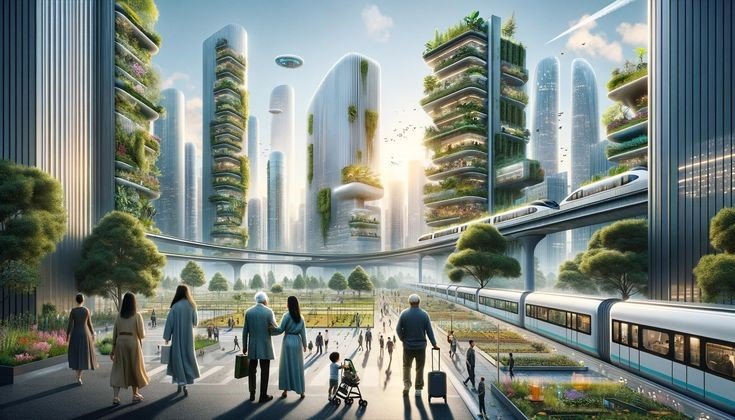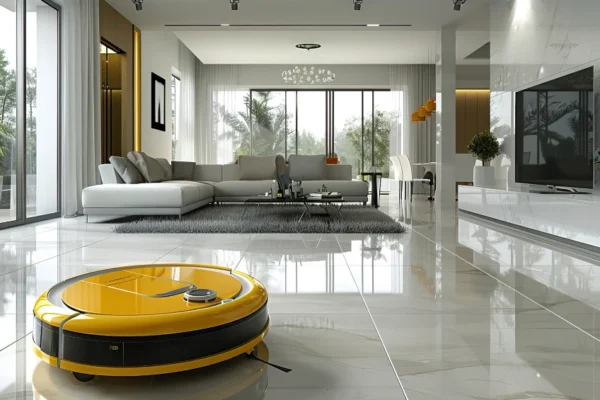As urban populations grow and infrastructure faces increasing pressure, cities worldwide are turning to innovation for solutions. This gives rise to the concept of Smart Cities of Tomorrow — urban environments where cutting-edge technologies work together to create safer, more efficient, and more sustainable living spaces. From intelligent transportation to energy-efficient buildings, the vision for the future revolves around interconnected systems that enhance everyday life.
Smart Cities of Tomorrow are not just futuristic dreams; they are rapidly becoming a global necessity. This article explores how technology is reshaping the way we live, work, and interact in urban settings — and how the cities of the future will look, feel, and function.
What Are Smart Cities?
Smart cities are urban areas that integrate digital technologies to improve the quality of life for residents. This includes real-time data collection, smart grids, IoT (Internet of Things) devices, and AI-based systems. The goal is to use data and connectivity to make urban services more efficient and responsive.
In the context of Smart Cities of Tomorrow, the approach goes beyond basic smart upgrades. It involves a city-wide ecosystem where transportation, healthcare, education, waste management, and energy systems all communicate with one another to optimize operations and improve outcomes for citizens.
Key Technologies Powering Smart Cities of Tomorrow
1. Internet of Things (IoT)
IoT is at the heart of Smart Cities of Tomorrow. IoT devices — such as smart traffic lights, pollution sensors, and smart water meters — collect data from across the city and transmit it to centralized platforms for analysis.
For example, smart streetlights adjust brightness based on the presence of pedestrians or vehicles, saving energy. Similarly, connected sensors in waste bins can alert sanitation departments when they need emptying, streamlining waste collection. Online platforms like SmartCitiesWorld regularly share updates on how IoT is shaping urban infrastructure across the globe.
2. Artificial Intelligence (AI) and Machine Learning
AI and machine learning enable predictive analytics and real-time decision-making. In Smart Cities of Tomorrow, AI will manage everything from traffic flow to public safety. For instance, predictive policing systems can identify crime hotspots, while AI-powered healthcare platforms can monitor the health patterns of city dwellers and offer personalized suggestions.
These technologies not only increase efficiency but also enable proactive responses to challenges, reducing emergencies and improving safety.
3. 5G Connectivity
Faster and more reliable than previous networks, 5G is essential for Smart Cities of Tomorrow. It allows real-time data transmission from billions of IoT devices. From autonomous vehicles to connected public infrastructure, 5G ensures seamless, low-latency communication.
This level of connectivity will support innovations like remote surgeries, immersive VR education, and smart mobility solutions that rely on constant real-time updates.
4. Big Data Analytics
Data is the backbone of any smart city. Massive amounts of data are generated daily — from mobile apps, traffic sensors, and environmental monitors. Big Data analytics allows cities to process this information to make informed decisions.
In Smart Cities of Tomorrow, big data will be used to analyze traffic patterns, improve emergency response times, and even forecast infrastructure maintenance needs.
Smart Mobility and Transportation
One of the most visible impacts of Smart Cities of Tomorrow will be on transportation. The integration of smart traffic signals, autonomous vehicles, and real-time transit apps will create a smoother, more efficient commuting experience.
Key developments include:
-
Autonomous Vehicles: Self-driving cars and public transport reduce accidents and optimize road usage.
-
Shared Mobility: Bike-sharing, car-sharing, and ride-hailing services will be seamlessly integrated through apps.
-
Smart Traffic Systems: Real-time data helps manage congestion and reroute traffic during peak hours.
These systems aim to reduce traffic jams, lower emissions, and improve accessibility for all citizens.
Sustainable Urban Living
Sustainability is central to the vision for Smart Cities of Tomorrow. As climate change intensifies, cities must adopt green technologies to reduce their environmental footprint.
1. Smart Energy Management
Smart grids and renewable energy sources are vital. Smart meters allow residents and city planners to monitor energy use, encouraging conservation. Some cities are experimenting with solar roads and buildings equipped with solar panels and energy-efficient materials.
2. Water and Waste Management
Smart water systems detect leaks and reduce wastage. In Singapore, smart sensors monitor the quality and distribution of water in real time. Similarly, automated waste sorting and collection systems help reduce landfills and promote recycling.
3. Green Building Technologies
Smart Cities of Tomorrow will prioritize green architecture. Buildings will be designed with smart ventilation, automatic lighting systems, and materials that adapt to climate conditions. LEED-certified and net-zero buildings will become the standard rather than the exception.
Healthcare and Wellbeing in Smart Cities
Technology is also transforming how healthcare is delivered in urban areas. In Smart Cities of Tomorrow, hospitals, clinics, and even homes will be equipped with smart systems to support better health outcomes.
-
Telemedicine: Remote consultations and diagnostics reduce the burden on hospitals.
-
Wearable Devices: Track heart rate, sleep, glucose levels, and more — all synced with health systems.
-
Smart Hospitals: AI-driven diagnostics, robotic surgeries, and patient management systems improve accuracy and efficiency.
Additionally, mental health monitoring and air quality sensors will be integrated into public spaces to ensure overall well-being.
Education and Digital Literacy
The educational systems in Smart Cities of Tomorrow will be inclusive, digital-first, and AI-supported. Schools will adopt virtual reality (VR) classrooms, personalized AI tutors, and collaborative platforms that connect students across the globe.
Free public Wi-Fi, digital learning hubs, and open-source resources will bridge the gap between low-income communities and high-quality education, making learning more accessible and engaging.
Public Safety and Governance
Governments in Smart Cities of Tomorrow will be more transparent and responsive. Smart governance involves the use of digital tools to engage citizens, deliver services, and maintain security.
1. Smart Policing
AI and predictive analytics help law enforcement monitor high-risk areas. Surveillance systems integrated with facial recognition and crime prediction tools will improve response times and deter criminal activity.
2. E-Governance
Citizens can access public services, pay bills, and lodge complaints through centralized platforms and mobile apps. E-voting and blockchain-based governance models will ensure greater transparency and citizen participation.
Challenges Facing Smart Cities of Tomorrow
While the promise is immense, Smart Cities of Tomorrow face several challenges:
-
Data Privacy: With so much personal and behavioral data being collected, ensuring privacy is a top concern.
-
Cybersecurity: As systems become more connected, they also become more vulnerable to attacks.
-
Digital Divide: Not all citizens have equal access to technology, creating potential inequality.
-
High Initial Investment: The infrastructure for smart systems requires significant upfront capital.
Addressing these challenges is essential for building inclusive and resilient smart cities.
Global Examples of Smart Cities in Progress
Several cities are already on their way to becoming Smart Cities of Tomorrow:
-
Singapore is known for its smart traffic systems, clean tech, and efficient public services.
-
Barcelona: Focuses on smart lighting, e-governance, and urban mobility.
-
Amsterdam: Implements smart energy systems and open data initiatives.
-
Dubai: Aims to be the smartest city by 2030 with projects like AI-driven police stations and blockchain governance.
These cities provide real-world examples of what’s possible when technology and urban planning work hand in hand.
Conclusion
The Smart Cities of Tomorrow represent a fundamental shift in how urban areas function and serve their citizens. They promise a future where technology is embedded in the very fabric of city life — improving transportation, reducing environmental impact, enhancing healthcare, and transforming education.
As we stand at the edge of this digital transformation, cities must plan, invest, and innovate responsibly to create urban environments that are inclusive, secure, and sustainable. With the right policies, infrastructure, and public engagement, Smart Cities of Tomorrow will not only address today’s urban challenges but also unlock new possibilities for generations to come.





